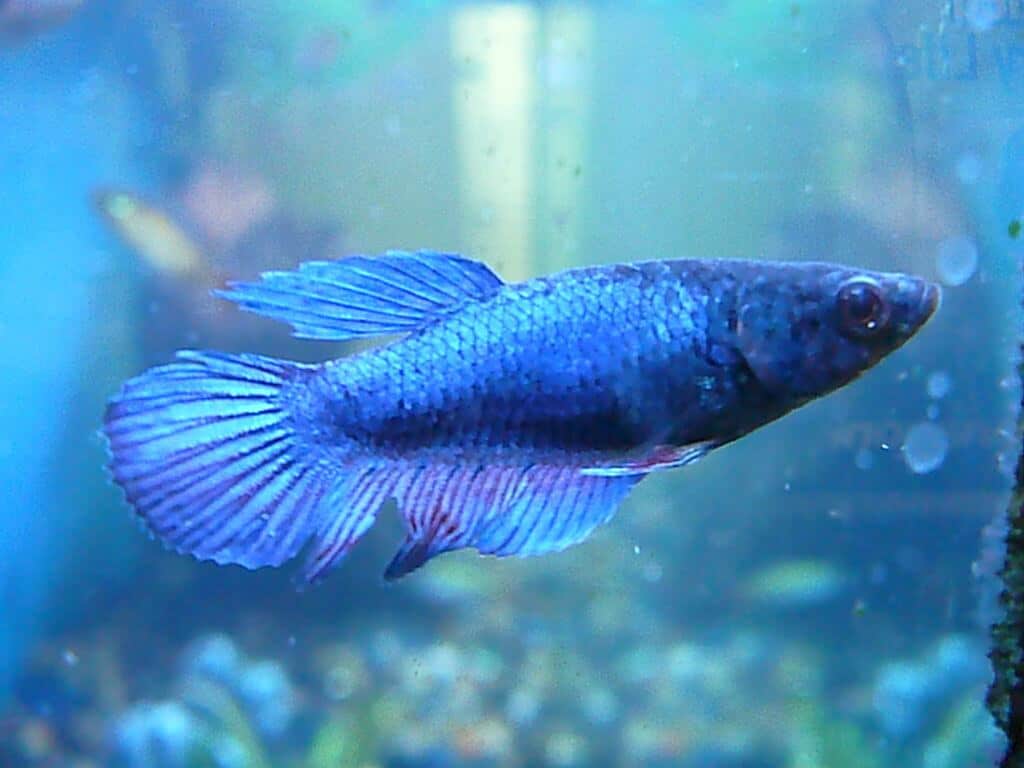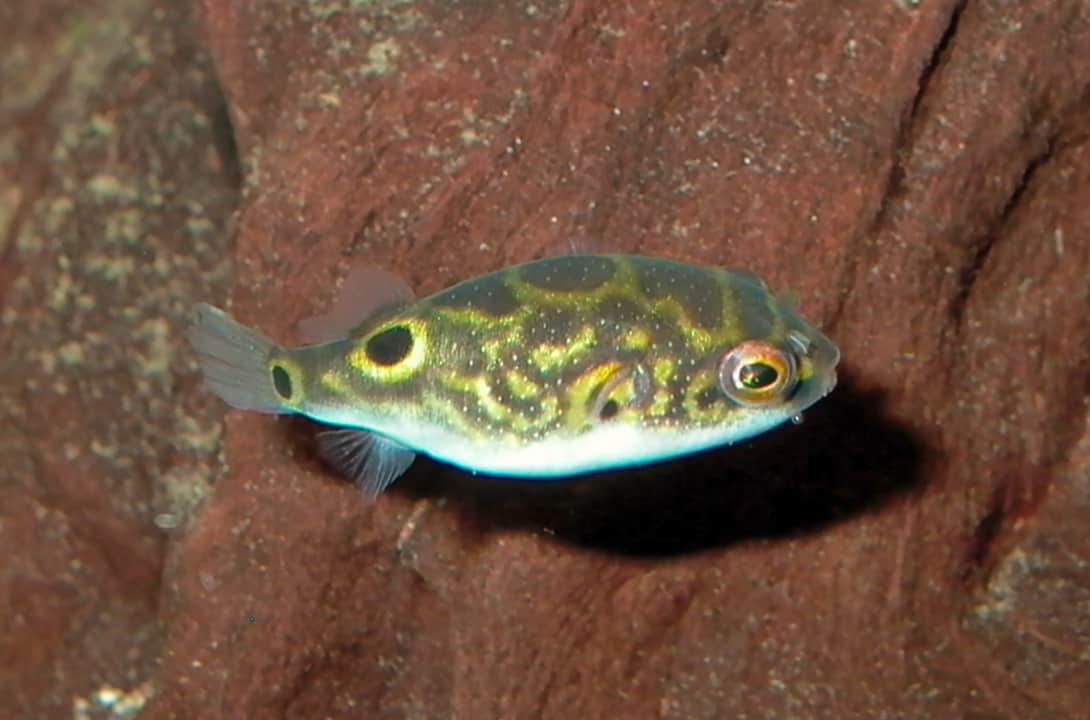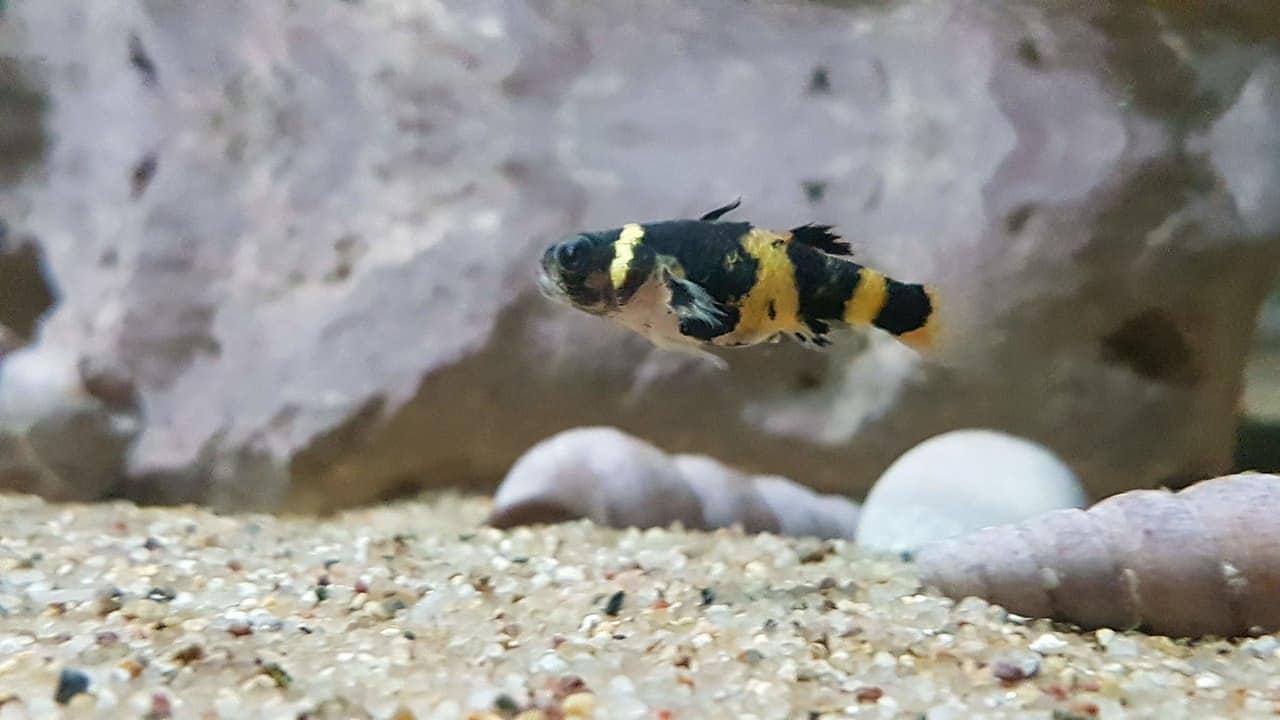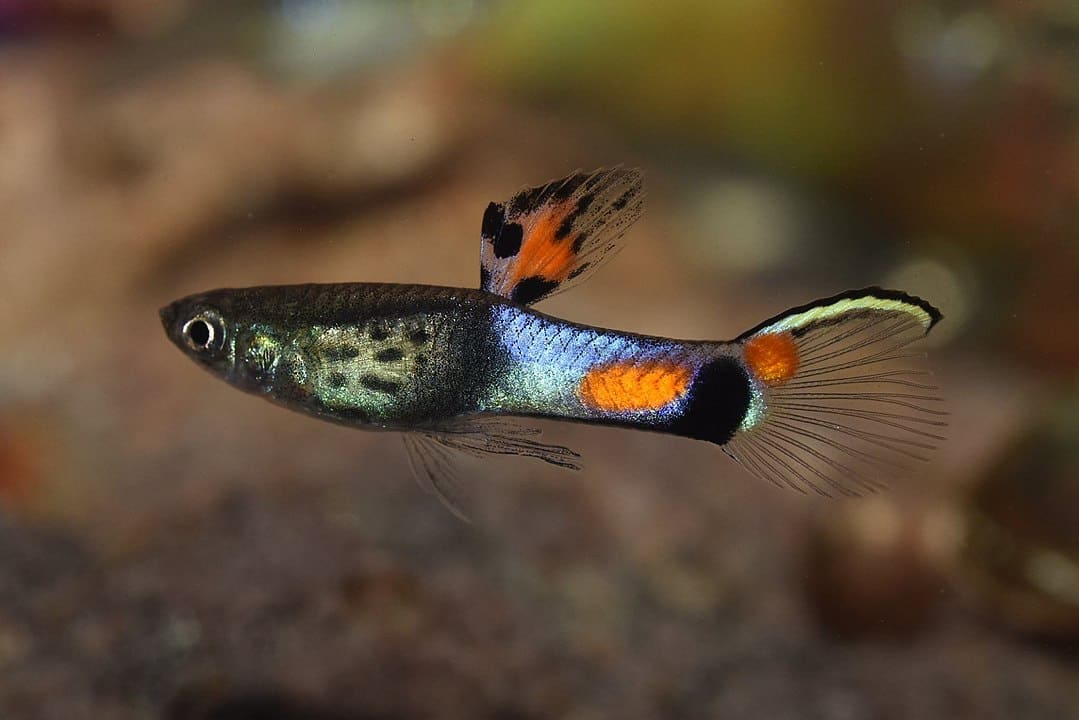Small tanks are getting to be a trend in the fish keeping hobby for the newbies. Even the experienced hobbyists prefer it to house small aquarium fish.
Tiny fishes forming a school can fascinate the eye and set the mood in any room. It’s a cool table art!
Whether the aquascape is Nature, Dutch or Biotope, your nano aquarium is not complete without including miniature fishes.
This article provides tips on stocking up your 5-gallon or 10-gallon up to 20-gallon mini-ecosystem. The guide will help you decide what kind of Nano Fish is best for your microsystem.
Top 18 Fish for Nano Aquarium
Betta Fish

Betta
- Adult Size: 2.5 inches (excluding the tail)
- Lifespan: 3 years in captivity, 20 years in the wild
- Origin: Thailand, Cambodia, Laos, Vietnam
- Scientific Name: Betta splendens
- Tank size: minimum of 5 gallons
- Temperature: 72 to 82°F
- pH: 6.5 to 7.5
- Food:
- freeze-dried bloodworms
- live and frozen food
- crushed flakes
- pellets
If you're wondering where this beauty came from, the answer is the Mekong basin in Thailand and its neighboring countries. During wet seasons, people see these fish in rice paddies, canals, and floodplains. But these wetlands can dry out in summer, so they are not a stable habitat for this fish.
Bettas are hardy and have vibrant colors, and their fins come from wide morph variations. They flare their fins to show off when aggressive. If they see flowing fins from other fishes, they might attack them. They want these characteristics only belonging to them.
The Betta Fish or otherwise known as Siamese fighting fish is a member of gourami species. The female Betta can join a community tank but not the male.
Males can be aggressive, and both male and females can be territorial. They can attack one another and fight until death, hence the name “fighting fish.”
Other than breeding purposes, a male must separate from a female. One or two females and a male can be in one tank when sexing.
You often see these fish in a bowl or cup because they can survive in a small space. Your LFS has lots of these cups as “marketing gimmick.” It means they are not delicate to maintain. Least that you know these dishes are better off isolated because of its wild behavior to other tank mates its own same species.
Like gouramis, Bettas have a labyrinth organ (besides gills) that can enable them to breathe water’s surface.
Asian Stone Catfish
- Adult Size: 1.2 inches
- Origin: India and Southeast Asia
- Scientific Name: Hara jerdoni
- Tank Size: 5 gallons minimum
- pH: 5.6 to 7.6
- Food:
- dried pellets
- tubifex worms
- Bloodworms
- brine shrimps
- Daphnia
- and other small pieces of live and frozen food
From the species of catfish, the Asian Stone Catfish is a tiny whiskered fish but cute and unique. If you like swimming fish, this might not be for you because it stays in one place and hides for a more extended period.
However, you can join this with other micro fish species, can also be in solo or a pair. Although I like the appearance, I am not a fan of inactive fishes like bottom dwellers for I would always prefer a fish that swims and moves a lot.
The stone catfish is nocturnal, so the best feeding time is when the dark breaks in. It hides in driftwoods, almond leaves or dwells in the substrate. Keep its environment clean and with stable, well-oxygenated water.
Scarlet Gem
- Adult Size: .75 to 1 inch
- Origin: India
- Scientific Name: Dario Dario
- pH: 6.5 to 7.6
- Tank size: minimum of 5 gallons or 10 gallons for a pair
- Food:
- brine shrimps
- banana worms
- Daphnia
- and a variety of live and frozen food
Scarlet Gem is hard to maintain because it is prone to diseases. Do not feed it with dried foods as they always prefer live feeds.
I omitted tubifex worms and bloodworms in its diet because it can become obese.
Scarlet badis has a body shape that looks like a dwarf cichlid, yet not at all related. It is one of the timid and peaceful small aquarium fish in the LFS.
I kept a pair of Badis in my 10-gallon Leiden style tank. They are always in a love-hate temperament that matches their love nest, which is my Dutch-inspired mini aquarium.
Pygmy Cory Catfish
- Adult Size: 1.3 inches
- Origin: South America
- Scientific Name: Corydoras pygmaeus
- Tank size: minimum of 5 gallons
- pH: 6.5 to 7.6
- Diet: Omnivorous
- Food:
- sinking foods
- tubifex worms
- Bloodworms
- and a variety of frozen food
Majority of Corydoras species are bottom-dwellers, but the Pygmy Cory Cats (C. pygmaeus), the Tail Spot (C. hastatus), and the Salt and Pepper Cory (C. hasbrosus) are not scavengers neither leftover food eaters nor bottom cleaners.
They are too tiny to be a “cleanup crew.” These Cory species are peaceful and would love to form a school.
They prefer to swim in the middle and lower water levels. Keep 3-6 specimens in a nano aquarium for a stunning aquarium display.
Tiny Gouramis (Pygmy Gouramis or Dwarf Gouramis)
- Adult Size: 1.5 inches
- Origin: Southeast Asia
- Scientific Name: Trichopsis pumila
- Tank size: minimum of 5 gallons
- pH: 5.0 to 7.0
- Food:
- dried pellets (for training)
- Daphnia
- tubifex worms
- brine shrimps
- Bloodworms
- and other mixed pieces of live and frozen food
In the wild, tiny gourami like the sparkling gourami is micro-predators. This is the reason why they do not like pellets and dried food.
Dwarf gourami is peaceful and can be in pairs, in groups or with other Nano Fish in a typical community as long as you meet the required gallons of water.
Since they are labyrinth fishes (having a labyrinth organ), they can breathe air from the water surface. They are hard to maintain while in captivity as they prefer to be in a soft, acidic, slow-moving, and low oxygenated waters like flooded fields, pools, and swamps.
If you prefer to keep pygmy gouramis, a nature style aquarium with driftwoods and almond leaves is ideal. They are not adaptable to mineral-enriched water, so use distilled water (purified through reverse osmosis).
Pea Puffer

- Adult Size: 1 inch
- Origin: Southern India
- Scientific Name: Carinotetraodon travancoricus
- Tank size: minimum of 5 gallons or 10 gallons for 3 or more specimens
- pH: 7.0 to 7.6
- Diet: Carnivorous
- Food:
- bloodworms
- worms in its natural habitat
- small crustaceans
- frozen brine shrimps
- Mollusks
- Krill
- live nails
With their sharp teeth, this freshwater pufferfish is a bully towards other tank mates and even with each other in the species group.
Although they can join with small gobies like the bumblebee goby and small catfish, make sure that the water allocation is sufficient for the number of species in a nano aquarium.
Pea puffers are the smallest and the cutest of the many species of puffers. You can house three specimens in a 5-gallon tank provided there’s only a male to two females.
They love to hide; therefore, a planted aquarium is best for them. They are intuitive that they can swim in the water surface when you get nearer the tank.
When threatened, they can inflate their stomach with air or water until they triple in sizes; hence the puffer name existed.
Otocinclus Catfish
- Adult Size: 2 inches
- Origin: South America
- Scientific Name: Otocinclus sp.
- Tank size: minimum of 5 gallons
- pH: 6.8 to 7.5
- Diet: Herbivorous
- Food:
- algae
- Pellets
- Wafers
- and other algae-based feeds
The Otocinclus catfish is a tiny lawnmower in your tank. It consumes algae and would prefer nothing else.
“Oto” helps eliminate unwanted algae, the ones that stick on the glass, plants, and decor of your aquarium.
Two to six ‘Oto’ catfish can form a stunning school as they can adapt to any micro-ecosystem. If you are looking for a helpful freshwater fish for a nano tank, your LFS advisors are most likely to recommend the peaceful “Oto.”
Bumblebee Goby

JSutton93 [CC BY-SA 4.0 (https://creativecommons.org/licenses/by-sa/4.0)]
- Adult Size: 1.5 inches
- Origin: Southeast Asia
- Scientific Name: Brachygobius doriae
- Tank size: minimum of 5 gallons
- pH: 7.4 to 8.2
- Diet: Carnivorous
- Food:
- tubifex worms
- Bloodworms
- brine shrimps
- Daphnia
- and other live and frozen food
The only fish in this list that suits brackish water is this beautiful Bumblebee Goby. It will look more vibrant in salty and acidic environments.
Your fish advisor will tell you how to achieve the best salinity for this nano fish that resembles the body marks of a bumblebee.
The bumblebee goby can also adapt in freshwater as long as you sustain them and provide an equilibrium in its little environment.
The difference in salinity does not affect as much.
Bumblebee Goby is peaceful but can turn aggressive if you housed more in a nano tank. Keep one bumblebee goby in a 5-gallon and a pair in a 10-gallon aquarium.
Micro Cyprinids

Harlequin Rasboras
- Adult Size: .75 to 1 inch
- Origin: Southeast Asia and Taiwan
- Family: Ciprinidae
- Genus: Rasbora
- Tank size: minimum of 5 gallons
- pH: 7.0 to 7.6
- Diet: Omnivorous
- Food:
- small pelleted food
- freeze-dried snacks
- Flakes
- Daphnia
- tubifex worms
- brine shrimps
- Bloodworms
- live and frozen foods
The tiniest fish you can load in your nano tank is the micro rasboras, also known as micro cyprinids.
There are several species of these miniature carp-like fish from the family of Ciprinidae.
You will love them in a shoal of 6 or more because of their bright colors. These schooling fish are peaceful but active.
They show their best when they are hiding, so provide your nano tank with hiding places no matter how small it is.
Because of their timid nature, they feel safe when hiding. You will notice their colors turning more brilliant when not stressed or threatened.
Amanda Tetra (or Ember Tetra)
- Adult Size: .75 inches
- Origin: South America
- Scientific Name: Hyphessobrycon amandae
- Tank size: minimum of 5 gallons
- pH: 6.5 to 7.2
- Food:
- micro pellets
- Flakes
- frozen tubifex worms
- planktonic foods
- frozen brine shrimps
Amanda or Ember Tetras looked like floating flames underwater when 5 of them or more form a shoal. Neon Tetras used to join them because Ember Tetras are peaceful and active too.
They looked like a shoal of bright beams when on a darker substrate. Ember Tetras love schooling in the midsection of the tank.
Although they can survive in freshwater, a slight salinity is better. They are endemic to soft water but can also adapt to any range of hardness.
Annual Bluefin Killifish
- Adult Size: 2 inches
- Origin: South Africa
- Scientific Name: Nothobranchius rachovii
- Tank size: minimum of 5 gallons
- pH: 6.0 to 7.2
- Diet: Carnivorous
- Food:
- tubifex worms
- Bloodworms
- white worms
- grindal worms
- frozen/relish brine shrimps nauplii
- daphnia
These colorful small aquarium fish are surface feeders and plant spawners.
Killies are friends to Neon Tetras and Rummy Nose Tetras. They are both schooling fish and can swim all together in the middle part of the tank.
These cute oddballs love to stay in flooded areas, swamps and pools during the wet season when they lay their eggs.
Habitats like these can desiccate when a dry season comes leading to the death of several killifishes.
They have a longer lifespan of two years while in captivity compared to a shorter 3 to 9 months lifespan in the wild.
Endler’s Livebearers

Dgrummon [CC BY-SA 4.0 (https://creativecommons.org/licenses/by-sa/4.0)]
- Adult Size: 1 inch (male), 1.5 inch (female)
- Origin: Venezuela
- Scientific Name: Poecilia wingei
- Tank size: minimum of 5 gallons
- pH: 7.0 to 7.6
- Diet: Omnivorous
- Food:
- Flakes
- Micro-pellets
- frozen bloodworms
- brine shrimps
- daphnia
Endlers livebearers are fun and colorful. They are hardy and easy to keep. For a novice, these make a good start because they can multiply.
They look smaller than the common guppy, therefore for other tank mates, these make a tasty snack. Although adult guppies eat their offspring, Endler’s livebearers do not.
Endlers are active fish, and they beg for food if they see you around. They are not shy and are not fussy in hiding under live plants. They feel safe in a shoal, but they are better off in a pair.
Many species of Guppies hybridize with these small aquarium fish, and they interbreed proficiently.
Since they feel safe and cared for in captivity, Endler’s livebearers can live up to two years in an aquarium.
Sixray Corydoras

Cedricguppy - Loury Cédric [CC BY-SA 4.0 (https://creativecommons.org/licenses/by-sa/4.0)]
- Adult Size: 1.1 inches
- Lifespan: 5 years
- Origin: Brazil
- Scientific Name: Aspidoras pauciradiatus
- Tank size: minimum of 10 gallons
- Temperature: 72 to 77 °F
- pH: 6.0 to 7.2
- Diet: Omnivorous
- Food:
- Pellets
- bottom feeder tablets
- Flakes
- Plants
- leftover pieces of live and frozen food
Sixray Corydoras and the rest of Cory Catfish species are freshwater bottom feeders/dwellers famous in pet stores.
They are hardy fish, hence known as “armored catfish” because of its different bone-like body structure.
They would love a tropical environment that mimics the wild where they are adept with. A planted aquarium is an ideal hiding place and where they can also conceal their fry.
If tank size permits, Cory Catfish feels safer when they group in six or more to form a shoal. Their schooling behavior is an exciting sight to view as these small aquarium fish moves in sync like a dance ensemble.
Neon Tetra

Paracheirodon Simulans (Green Neon)
- Adult Size: 1.3 inches
- Lifespan: 5 years in an aquarium, 8 to 10 years in the wild
- Origin: Brazil, Peru, and Colombia in South America
- Scientific Name: Paracheirodon innesi
- Tank size: minimum of 5 gallons, or 20 gallons for the schooling of 15-20 specimens
- Temperature: 70 to 77F
- pH: 6.0 to 6.5
- Diet: Omnivorous
- Food:
- Micro-pellets
- Flakes
- tubifex worms
- freeze-dried bloodworms
- brine shrimps
- Daphnia
- other live and frozen food
For beginner aquarists, this fish will make a good start. It is easy to maintain Neon Tetras because they are tiny, peaceful and can get along well with other tank mates of their size.
I set up my nano aquarium into a tropical setting, which I know is a perfect match for this schooling fish.
They can adapt to a planted ecosystem that looks and feels similar to their known habitat.
Neon Tetras are mid-level fish that form a school (15-20 members) with the same species. They feel comfortable when they are plenty, but sometimes they swim with the dwarf guppies and would love to play around.
You will love the vibrant colors of these fish in red, metallic blue and translucent. When stressed and threatened, their colors fade.
The Neon Tetra is a popular freshwater fish for nano tank in the fish-keeping hobby with over 2 million specimens sold in the USA every month.
Green Neon Tetra

- Adult Size: 1 to 1.3 inches
- Lifespan: 2 to 3 yrs. or longer
- Origin: Amazon River Basin, South America
- Scientific Name: Paracheirodon simulans
- Tank size: minimum of 12 gallons or 20 gallons for the schooling of 15-20 members
- Temperature: 75 to 84F
- pH: 5.0 to 7.8
- Tank Region: midsection to upper
- Diet: Omnivorous
- Food:
- small insects
- Zooplankton
- Crustaceans
- Pellets
- Flakes
- tubifex worms
- Cyclops-eeze
- Bloodworms
- baby brine shrimps
- Daphnia
- decaying leaves
- other live and frozen mixed food
Also known as False Neon Tetra, this schooling fish are almost alike and can be mistaken for the Cardinal Tetra. The difference is the green coloration of the Green Neon Tetra from head to tail, hence where it got its name.
Green Neon Tetras are beautiful and peaceful to other fish. They swim in a shoal of 6 to 10 members of their kind.
Some of its misbehavior - they are micro-predators, and the male Green Neon Tetras compete with other males of the same species when they want attention from a female.
They are hardy and are adept to any range of water parameters. although they are much better off in a soft and acidic water
These fish love to hide in a dim section of the tank so you may add some driftwoods to shade them on like in the black water condition. They depend on vegetation for additional food, so a planted tank is just perfect.
Green Neon Tetras are not similar to the Neon Tetras, although both are ideal small aquarium fish...
The difference lies in the length of metallic blue-green coloration on their bodies. Their red colors are lighter, and the blue-green color is more vibrant and defined than that of the Neon Tetra.
Although these colorations are not so striking to other fish hobbyists, its size is perfect for a nano aquarium.
Green Neon Tetra is a schooling fish, and they feel safer swimming in a group of 10-20 individuals.
Galaxy Danio (or Celestial Pearl Danio)

Photo by Lindy de Bruyn
- Adult Size: 1.5 inches
- Lifespan: 3 to 5 years
- Origin: Myanmar, Thailand
- Scientific Name: Celestichthys margaritatus
- Tank size: minimum of 5 gallons or 10 gallons for schooling (6 members)
- pH: 6.5 to 7.5
- Diet: Omnivorous
- Food:
- Algae
- Zooplankton
- small invertebrates
- Flakes
- algae wafers
- freeze-dried bloodworms
- brine shrimps
Danios came from a group of Cyprinids species, and the Celestial Pearl or Galaxy Danios are the tiniest in its group.
Because of its striking color, a schooling fish like these can exhibit an exciting view.
The Galaxy Danio, (or galaxy rasbora) is native to freshwaters of Southeast Asia.
Discovered in 2006, Celestial Danios became the most sought-after Danios species ever.
Galaxy Rasbora is a gentle and peaceful fish. It has white spots on its body where it got its name “galaxy” or “celestial.” The fins are brilliant red and very visible from a nano aquarium*.
Danios vary in sizes and shapes as there are six known variations and the Galaxy Danio is the most popular small freshwater fish in this species group.

Photo by D.W. from Wikipedia
- Adult Size: 1.3 inches
- Origin: Venezuela and Columbia
- Scientific Name: Corydoras habrosus
- Tank size: minimum of 10 gallons
- pH: 5.5 to 7.5
- Temperature: 75 to 78F
- Food:
- Pellets
- Flakes
- Rotifers
- cyclops
- baby brine shrimps
Salt and Pepper Catfish are native to tropical environments. They love to stay in a planted aquarium with a dark substrate.
In the wild, they inhabit wetlands and shallow waterways which can dry out when the wet season ends. This can endanger the species in its group.
They enjoy a planted aquarium, a replicated biotope of where they are used to. These are schooling fish of which ten or more members of its species can join.
These fish has a habit of gulping air from the water surface. This sign is not usual with other fish species (other than salt and pepper catfish) because it signals a low level of oxygen in your tank.
Salt and Pepper Catfish is a peaceful and timid fish that you can keep in a nano aquarium with other smaller species of fish like Ember (or Amanda) Tetras, Endler’s Guppies, Clown Panchax, and tiny Rasbora species.
Licorice Gouramis
- Adult Size: 1.3 inches
- Origin: Southeast Asia
- Scientific Name: Parosphromenus deissneri
- Tank size: minimum of 5 gallons
- Temperature: 74 to 82F
- pH: 5.6 to 7.2
- Diet: Carnivorous
- Food:
- brine shrimps
- Microworms
- frozen and live foods
- meaty and plant-based foods
Like Pygmy Gouramis (or sparkling gouramis), Licorice Gouramis are one of the small aquarium fish that are not for beginner enthusiasts.
Because of its tiny size, they are delicate to take care of but pleasing to the eyes. It has silver and black coloration on its body.
There are twenty endangered species of Licorice Gouramis in the wild because of the destructed habitats.
We often not see the genuine ones in the market. You are likely to buy similar species that can grow larger than 1.3 inches, which is the original size of true licorice gourami.
The fish prefer a planted aquarium with driftwoods and caves to hide from. The shade will make a licorice gouramis feel safe.
It stays on the bedding for a longer time and on the water surface, unlike its cousin (dwarf/pygmy gourami).
All gouramis are labyrinth fishes that they have a particular organ that can allow them to breathe on the surface of slightly acidic water.
Being a gentle and peaceful fish, the Licorice Gouramis like to join other tiny and good-natured fish.
Since they are bottom feeders, they generate wastes as much, so you need an effective chemical and biological filtration.
Final Thoughts
What to consider in stocking freshwater fish for nano tank?
There are tons of fish options available in the fish keeping trade. I have provided a list of shy, peaceful, and small aquarium fish that can adapt to a collective community.
The rule of thumb to remember is at least one gallon for every inch of a miniature fish. This may not apply to all because some species require more space, and some can survive on just 5 gallons of water.
The 10-gallon nano tank is ideal, but you should not overstock it.
You need a stocking calculator to determine the allowable number of tiny fishes to a house in one micro-ecosystem.
In this list are schooling fish, so they are perfect to be in a one-species tank. You can join some with the others except for the pea puffers that are better off with their species.
I found it necessary to have a variety of nano fish as if they’re in the wild. A mix and match of these can be colorful in my mini-environment.
Your local fish store will recommend the best combination. Do your research too.
Not because these fish are tiny, maintenance is less. Stuck up wastes and leftover food debris can build up toxins and pollutants that may pose a danger to your fish and plants.
Small aquariums have limited space that might allow pollutants to concentrate.
They are susceptible to parameter fluctuations within the slightest of change.
So, change the water every week. Check if your filtration and heater systems are all functioning well.
Overfed fish generate plenty of wastes so vacuuming or siphoning may be a task but even more beneficial.

